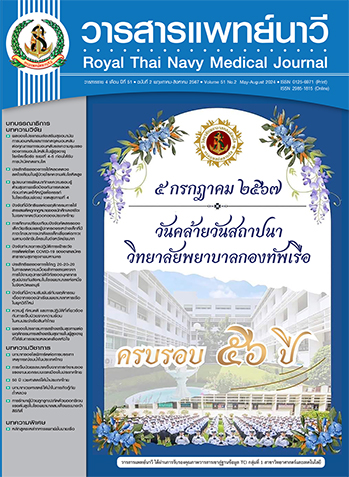The Roles of Lifeguards in Mitigating Drowning Incidents in Thailand
Main Article Content
Abstract
Drowning is a major cause of unintentional death globally, posing significant public health implications that greatly impact economies and societies. According to the World Health Organization (2014), an estimated 91% of drowning incidents occur in countries with low to middle incomes levels. In Thailand, data shows that children under 15 years old have a mortality rate from drowning ranging from 5 to 8.6 per 100,000 population.
The International Life Saving Federation has identified several noteworthy risk factors, which includes the following: lack of knowledge, understanding, and negligence towards potential threats, as well as insufficient information and unrestricted access to hazardous areas, lack of survival skills when facing emergency situations, lack of supervision and vigilance, and other risk factors that may occur simultaneously.
Therefore, in areas with high risk of drowning incidents, it is crucial to have the presence of skilled personnel who can promptly assess risks and provide assistance. Additionally, drowning statistics in the area should be collected to utilize the data for planning prevention measures and reducing potential risks in the future.
Article Details

This work is licensed under a Creative Commons Attribution-NonCommercial-NoDerivatives 4.0 International License.
References
World Health Organization. Global report on drowning preventing a leading killer. Geneva: World Health Organization; 2014.
Hfocus. Thai people drown and die from accidents, an average of 10 people per day. [Internet]. [cited 2024 January 4]. Available from: https://www.hfocus.org/content/2023/03/27277. (in Thai).
Shappell SA, Wiegmann DA. HFAC The Human factors analysis and classification system (HFACS). [Internet]. [cited 2024 January 4]. Available: https://commons.erau.edu/publication/737
Tyler MD, Richards DB, Reske-Nielsen C, Saghafi O, Morse EA, Carey R, et al. The epidemiology of drowning in low- and middle-income countries: a systematic review. BMC Public Health 2017;17(1):413.
Joost JLM. Drowning: prevention, rescue, treatment. 2nd ed. Wiesbaden: Springer; 2014.
Willcox‐Pidgeon S, Franklin RC, Leggat PA, Devine S. Epidemiology of unintentional fatal drowning among migrants in Australia. Australian and New Zealand Journal of Public Health 2021;45(3):255-62.
Centers of Disease Control and Prevention. Drowning facts. [Internet]. [cited 2024 January 4]. Available from: https://www.cdc.gov/drowning/facts/index.html.
Moreland B, Ortmann N, Clemens T. Increased unintentional drowning deaths in 2020 by age, race/ethnicity, sex, and location, United States. J Safety Res 2022;82:463-8.
World Health Organization. Drowning. [Internet]. [cited 2024 January 4]. Available from: https://www.who.int/news-room/fact-sheets/detail/drowning.
Koon WA, Gates RM, Scoggins S, Andrus P, Futoran JA. The ocean lifeguard intervention continuum: a cognitive aid for surf lifeguard education. Int J Aquatic Res Educ 2020;12(4):e11.
The International Life Saving Federation Gemeenteplein. Drowning prevention strategies-International Life Saving Federation. n.p.; 2015.
Tipton M, Wooler A. The science of beach lifeguarding. Boca Raton, FL: CRC; 2016.
Tipton M, Montgomery H. The experience of drowning. Med Leg J 2022;90(1):17-26
Ministry of Public Health. Drowning prevention in Thailand. Bangkok: Department of Disease Control, Ministry of Public Health; 2014.
Division of Underwater and Aviation Medicine, Naval Medical Department. Underwater Medicine First Responder: UMFR. [Internet]. [cited 2024 January 4]. Available from: https://um.nmd.go.th/2023/. (in Thai).
International Life Saving Federation. Pool lifeguard. [Internet]. [cited 2024 January 4]. Available from: https://www.ilsf.org/wp-content/uploads/2007/09/APP%2008%20ILS%20Lifeguard%20Pool.pdf.
International Life Saving Federation. Inland open water lifeguard. [Internet]. [cited 2024 January 4]. Available from: https://www.ilsf.org/sites/ilsf.org/files/Certification/ILSCertificates/APP%2009%20ILS%20Lifeguard%20Inland%20Open%20Water_1.pdf.
Branche CM, Stewart S. Lifeguard effectiveness: a report of the working group. Atlanta: Centers for Disease Control and Prevention, National Center for Injury Prevention and Control. [Internet]. [cited 2024 January 4]. Available from: https://www.yumpu.com/en/document/view/27031865/lifeguard-effectiveness-a-report-of-the-working-group.
Surf Life Saving Australia. Rip Currents. [Internet]. [cited 2024 January 4]. Available from: http://www.beachsafe.org.au/surf-ed/Ripcurrents.
The Dolphin Project. [Internet]. [cited 2024 January 4]. Available from: http://www.ilsf.org/drowning-prevention/library/dolphin-project.
Witoonthat S. Reyes MR, Sarsycki M. Disaster Risk Assessment Manual Bangkok: United Nations Development Program, Thailand Office; 2016. (in Thai).
National Institute for Emergency Medicine. Universal coverage for emergency patients. [Internet]. [cited 2024 January 4]. Available from: https://www.niems.go.th/1/News/Detail/7452?group=3.
National Institute for Emergency Medicine. Guidelines for disbursing emergency medical funds. Bangkok: National Institute for Emergency Medicine; 2020. (In Thai).

